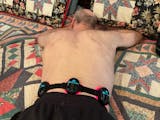Enhancing Pain Relief: Combining Dry Needling and Red Light Therapy for Myofascial Trigger Points
Myofascial pain syndrome, especially when it involves the upper trapezius muscle, is a prevalent and incapacitating condition that impacts numerous people. Conventional treatments such as dry needling (DN) have proven to be successful in relieving this pain, but recent studies indicate that combining DN with red light therapy may provide even more significant advantages. This piece explores the most recent discoveries from a randomized clinical trial that examined the combined effects of these treatments on myofascial trigger points.
Understanding Myofascial Trigger Points
Myofascial trigger points are hypersensitive areas located within a muscle that are linked to detectable lumps in tense muscle bands. These spots can result in notable pain and unease, frequently necessitating specific therapeutic treatments. Dry needling consists of inserting a fine needle into the trigger points to alleviate muscle tightness and alleviate pain. Red light therapy (formerly known as photobiomodulation) utilizes particular light wavelengths to penetrate tissues, fostering recovery and diminishing inflammation.
The Study on Dry Needling and Red Light Therapy
A recent randomized clinical study was conducted to assess the potential benefits of combining dry needling with red light therapy in treating active myofascial trigger points in the upper trapezius muscle. The study included 43 participants divided into three groups:
DN and Red Light Therapy (DNP)
Dry Needling (DN)
Dry Needling Outside of the Trigger Point (DNout)
The participants in each group underwent a single DN session followed by red light therapy, and the machine was either activated or deactivated as needed. The researchers evaluated pain, disability, pain pressure threshold, and muscle activity before the treatment and at 10-minute, 30-minute, one-week, and one-month intervals after the treatment.
Key Findings
The results of the study highlighted several important outcomes:
Pain Reduction
- DNP Group: Pain decreased by an average of 1.33 cm on the Visual Analog Scale (VAS) (95% confidence interval [CI], 0.019-2.647).
- DNout Group: Pain decreased by an average of 2.78 cm (95% CI, 1.170-2.973).
Disability Scores
Scores for the disability questionnaire decreased significantly in all groups post-intervention:
- DNP Group: Mean decrease of 3.8 points (95% CI, 1.082-5.518).
- DN Group: Mean decrease of 3.57 points (95% CI, 0.994-6.149).
- DNout Group: Mean decrease of 5.43 points (95% CI, 3.101-7.756).
Pain Pressure Threshold
There were no significant differences between or within groups regarding the pain pressure threshold:
- DNP Group: Mean difference after 30 minutes of 0.139 kgf (95% CI, -0.343 to 0.622).
- DN Group: Mean difference of 0.273 kgf (95% CI, -0.661 to 1.209).
- DNout Group: Mean difference of -0.07 kgf (95% CI, -0.465 to 0.324).
Muscle Activation
- DN Group: Muscle activation increased by 8.49% post-intervention.
- DNP Group: Muscle activation decreased by 11.5%, indicating a significant difference between groups.
Clinical Implications
The research suggests that the combination of dry needling with red light therapy (DNP) yields comparable outcomes to dry needling conducted away from the trigger point (DNout) and conventional dry needling (DN). Surprisingly, the DNout method demonstrated superior results in reducing pain and disability compared to DN administered directly at the trigger point.
The results indicate that red light therapy may serve as a beneficial complement to dry needling, potentially providing increased pain relief and better functional results for individuals with myofascial pain syndrome. The non-invasive characteristics and absence of negative side effects also encourage the inclusion of red light therapy in regular clinical procedures for treating musculoskeletal pain.
Conclusion
Red light therapy, in conjunction with dry needling, presents a hopeful progression in addressing myofascial trigger points. This novel method not only improves pain management and functionality more efficiently, but also boosts overall muscle performance. As studies delve deeper into the advantages of this dual treatment approach, medical professionals can anticipate integrating these successful therapies into their practice, providing patients with superior care and expedited recovery periods.
Visit our website to gain further knowledge and in-depth details regarding the utilization of red light therapy for pain management. Keep yourself informed about the most recent developments to deliver optimal care for your patients and improve their overall well-being.
















Share:
How to Properly Use a Red Light Therapy Device: Safety and Effectiveness Guide
Red light therapy: What is it and how does it work?